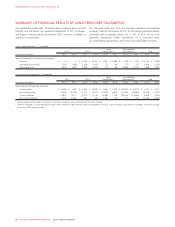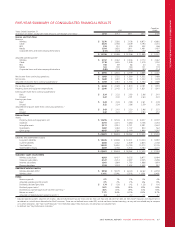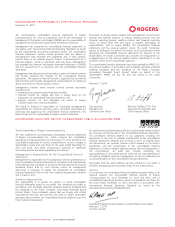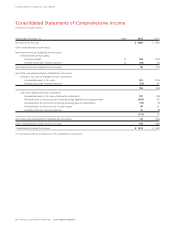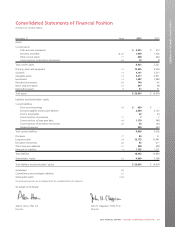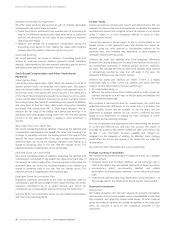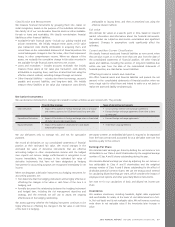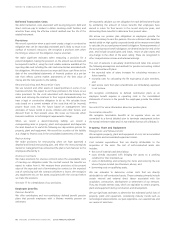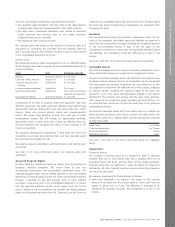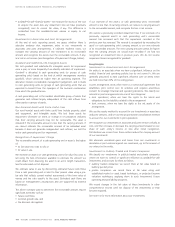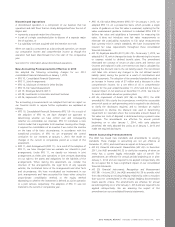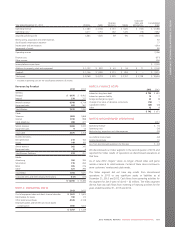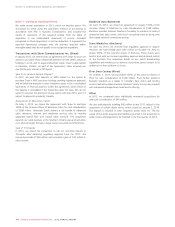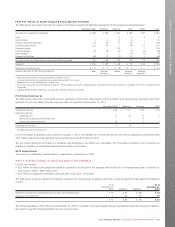Rogers 2013 Annual Report Download - page 100
Download and view the complete annual report
Please find page 100 of the 2013 Rogers annual report below. You can navigate through the pages in the report by either clicking on the pages listed below, or by using the keyword search tool below to find specific information within the annual report.NOTES TO CONSOLIDATED FINANCIAL STATEMENTS
Multiple Deliverable Arrangements
We offer some products and services as part of multiple deliverable
arrangements. We record these as follows:
• Divide the products and services into separate units of accounting, as
long as the delivered elements have stand-alone value to customers
and we can determine the fair value of any undelivered elements
objectively and reliably.
• Measure and allocate the arrangement consideration among the
accounting units based on their relative fair values and recognize
revenue when the relevant criteria are met for each unit.
Unearned Revenue
We record payments we receive in advance of providing goods and
services as unearned revenue. Advance payments include subscriber
deposits, cable installation fees and amounts subscribers pay for services
and subscriptions that will be provided in future periods.
Stock-Based Compensation and Other Stock-Based
Payments
Stock Option Plans
Cash-settled share appreciation rights (SARs) are attached to all stock
options granted under our employee stock option plan. This feature
allows the option holder to choose to receive a cash payment equal to
the intrinsic value of the option (the amount by which the market price
of the Class B Non-Voting share exceeds the exercise price of the option
on the exercise date) instead of exercising the option to acquire Class B
Non-Voting shares. We classify all outstanding stock options as liabilities
and carry them at their fair value, determined using option valuation
techniques that comply with IFRS 2, Share-based Payment. We re-
measure the fair value of the liability each period and amortize it to
operating costs using graded vesting, either over the four-year vesting
period or to the date an employee is eligible to retire (whichever is
shorter).
Restricted Share Unit (RSU) Plan
We record outstanding RSUs as liabilities, measuring the liabilities and
compensation costs based on the award’s fair value, and recording it as
a charge to operating costs over the vesting period of the award. If the
award’s fair value changes after it has been granted and before the
settlement date, we record the resulting changes in the liability as a
charge to operating costs in the year that the change occurs. The
payment amount is established as of the vesting date.
Deferred Share Unit (DSU) Plan
We record outstanding DSUs as liabilities, measuring the liabilities and
compensation costs based on the award’s fair value at the grant date. If
the award’s fair value changes after it has been granted and before the
settlement date, we record the resulting changes in our liability as a
charge to operating costs in the year that the change occurs. The
payment amount is established as of the exercise date.
Employee Share Accumulation Plan
Employees voluntarily participate in the share accumulation plan by
contributing a specified percentage of their regular earnings. We match
employee contributions up to a certain amount, and record our
contributions as a compensation expense in the year we make them.
See note 24 for more information about our stock-based compensation
and other stock-based payments.
Income Taxes
Income tax expense includes both current and deferred taxes. We use
judgment to interpret tax rules and regulations to calculate the expense
recorded each period. We recognize income tax expense in net income
unless it relates to an item recognized directly in equity or other
comprehensive income.
Current tax expense is tax we expect to pay or receive based on our
taxable income or loss during the year. We calculate the current tax
expense using tax rates enacted or substantively enacted at the
reporting date, and including any adjustment to taxes payable or
receivable related to previous years.
Deferred tax assets and liabilities arise from temporary differences
between the carrying amounts of the assets and liabilities we record in
our consolidated statements of financial position and their respective
tax bases. We calculate deferred tax assets and liabilities using enacted
or substantively enacted tax rates that will apply in the years the
temporary differences are expected to reverse.
Deferred tax assets and liabilities are offset if there is a legally
enforceable right to offset current tax liabilities and assets and they
relate to income taxes levied by the same authority on:
• the same taxable entity, or
• different tax entities where these entities intend to settle current tax
liabilities and assets on a net basis or the tax assets and liabilities will
be realized simultaneously.
We recognize a deferred tax asset for unused losses, tax credits and
deductible temporary differences to the extent that it is probable that
future taxable income will be available to use the asset. We use
judgement to evaluate whether we can recover a deferred tax asset
based on our assessment on existing tax laws, estimates of future
profitability and tax planning strategies.
We rely on estimates and assumptions when determining the amount
of current and deferred tax, and take into account the impact of
uncertain tax positions and whether additional taxes and interest may
be due. If new information becomes available and changes our
judgment on the adequacy of existing tax liabilities, these changes
would affect the income tax expense in the period that we make this
determination.
See note 9 for more information about our income taxes.
Foreign Currency Translation
We translate amounts denominated in foreign currencies into Canadian
dollars as follows:
• monetary assets and monetary liabilities – at the exchange rate in
effect at the date of the consolidated statements of financial position
• non-monetary assets, non-monetary liabilities and related
depreciation and amortization expenses – at the historical exchange
rates
• revenue and expenses other than depreciation and amortization – at
the average rate for the month when the transaction was recorded.
Financial Instruments
Recognition
We initially recognize cash and cash equivalents, accounts receivables,
debt securities and accounts payable and accrued liabilities on the date
they originate, and apply the criteria noted below. All other financial
assets and financial liabilities are initially recognized on the trade date
when we become a party to the contractual provision of the
instrument.
96 ROGERS COMMUNICATIONS INC. 2013 ANNUAL REPORT


